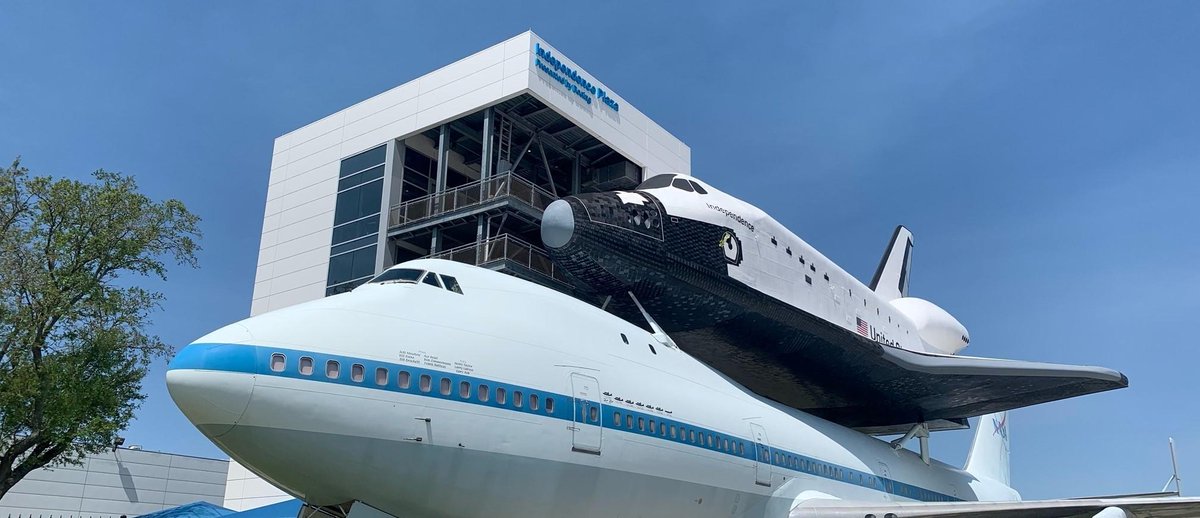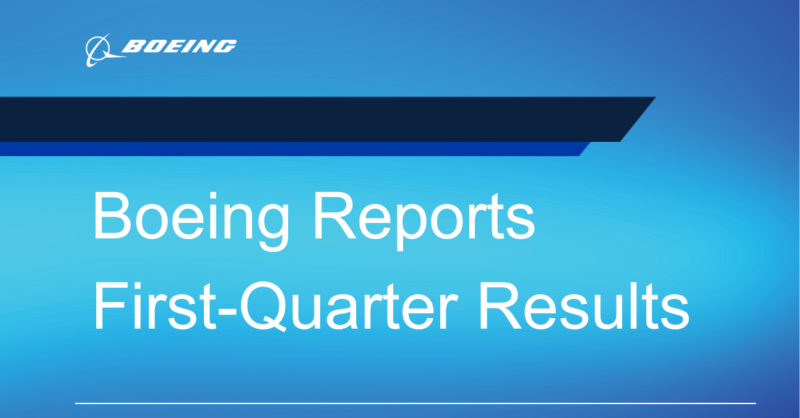
The Boeing Company [NYSE: BA] reported first-quarter revenue of $15.2 billion, primarily driven by lower 787 deliveries and commercial services volume, partially offset by higher 737 deliveries and higher KC-46A Tanker revenue (Table 1). GAAP loss per share of ($0.92) and core loss per share (non-GAAP)* of ($1.53) reflect year-over-year KC-46A Tanker improvement, higher 737 deliveries, and lower commercial airplanes period costs, partially offset by lower tax benefits and higher interest expense. Boeing recorded operating cash flow of ($3.4) billion.
“I am proud of the progress our global team made across our business in the first quarter as we continued to transform our enterprise, strengthen our safety processes, and sustain critical investments for our future,” said Boeing President and Chief Executive Officer Dave Calhoun. “While the global pandemic continues to challenge the overall market environment, we view 2021 as a key inflection point for our industry as vaccine distribution accelerates and we work together across government and industry to help enable a robust recovery. Our balanced commercial, defense, space and services portfolio continues to provide critical stability for our business — and we remain focused on safety, quality and integrity as we deliver on our customer commitments.”
|
Table 2. Cash Flow |
First Quarter |
||
|
(Millions) |
2021 |
2020 |
|
|
Operating Cash Flow |
($3,387) |
($4,302) |
|
|
Less Additions to Property, Plant & Equipment |
($291) |
($428) |
|
|
Free Cash Flow* |
($3,678) |
($4,730) |
|
|
*Non-GAAP measure; complete definitions of Boeing’s non-GAAP measures are on page 6, “Non-GAAP Measures Disclosures.” |
Operating cash flow improved to ($3.4) billion in the quarter, reflecting timing of receipts and expenditures and higher 737 deliveries, partially offset by lower 787 deliveries and lower advance payments (Table 2).
|
Table 3. Cash, Marketable Securities and Debt Balances |
Quarter-End |
||
|
(Billions) |
Q1 21 |
Q4 20 |
|
|
Cash |
$7.0 |
$7.8 |
|
|
Marketable Securities 1 |
$14.9 |
$17.8 |
|
|
Total |
$21.9 |
$25.6 |
|
|
Debt Balances: |
|||
|
The Boeing Company, net of intercompany loans to BCC |
$62.0 |
$62.0 |
|
|
Boeing Capital, including intercompany loans |
$1.6 |
$1.6 |
|
|
Total Consolidated Debt |
$63.6 |
$63.6 |
|
|
1 Marketable securities consists primarily of time deposits due within one year classified as “short-term investments.” |
Cash and investments in marketable securities decreased to $21.9 billion, compared to $25.6 billion at the beginning of the quarter, primarily driven by operating cash outflows (Table 3). The company refinanced $9.8 billion of debt in the quarter. Additionally, the company increased its revolving credit facilities by $5.3 billion to a total of $14.8 billion, which remain undrawn.
Total company backlog at quarter-end was $364 billion.
Segment Results
Commercial Airplanes
|
Table 4. Commercial Airplanes |
First Quarter |
||||
|
(Dollars in Millions) |
2021 |
2020 |
Change |
||
|
Commercial Airplanes Deliveries |
77 |
50 |
54% |
||
|
Revenues |
$4,269 |
$6,205 |
(31)% |
||
|
Loss from Operations |
($856) |
($2,068) |
NM |
||
|
Operating Margin |
(20.1)% |
(33.3)% |
NM |
||
Commercial Airplanes first-quarter revenue decreased to $4.3 billion, driven by lower 787 deliveries, partially offset by higher 737 deliveries (Table 4). First-quarter operating margin improved to (20.1) percent, primarily due to higher 737 deliveries and lower period costs.
Boeing is continuing to make progress on the safe return to service of the 737 MAX worldwide. In addition, we are working closely with the FAA and our customers to address electrical issues identified in certain locations in the flight deck of select 737 MAX airplanes. Since the FAA’s approval to return the 737 MAX to operations in November 2020, Boeing has delivered more than 85 737 MAX aircraft and 21 airlines have returned their fleets to service, safely flying more than 26,000 revenue flights totaling over 58,500 flight hours (as of April 26, 2021). The 737 program is currently producing at a low rate and continues to expect to gradually increase production to 31 per month in early 2022 with further gradual increases to correspond with market demand. The company will continue to assess the production rate plan as it monitors the market environment and engages in customer discussions.
The company also resumed 787 deliveries in late March, following comprehensive reviews to ensure each airplane meets the company’s highest standards. During the quarter, the 787 program consolidated final assembly to Boeing South Carolina and transitioned to the previously announced production rate of 5 aircraft per month.
Commercial Airplanes continues to work closely with global regulators on all aspects of 777X development, including its rigorous test program, and the company still expects to deliver the first 777X in late 2023. As previously announced, the combined 777/777X production rate is transitioning to 2 aircraft per month.

Commercial Airplanes secured orders for 100 737 aircraft from Southwest Airlines, 25 737 aircraft from United Airlines, 23 737 aircraft from Alaska Airlines, and four 747 freighter aircraft from Atlas Air. Commercial Airplanes delivered 77 airplanes during the quarter and backlog included over 4,000 airplanes valued at $283 billion.
Defense, Space & Security
|
Table 5. Defense, Space & Security |
First Quarter |
||||
|
(Dollars in Millions) |
2021 |
2020 |
Change |
||
|
Revenues |
$7,185 |
$6,042 |
19% |
||
|
Earnings from Operations |
$405 |
($191) |
NM |
||
|
Operating Margin |
5.6% |
(3.2)% |
NM |
||
Defense, Space & Security first-quarter revenue increased to $7.2 billion and first-quarter operating margin increased to 5.6 percent, primarily reflecting higher KC-46A Tanker revenue due to orders for 27 aircraft and the absence of charges related to the program, partially offset by a pre-tax charge of $318 million on the VC-25B program largely due to COVID-19 impacts and performance issues at a key supplier.
During the quarter, Defense, Space & Security was awarded Lots 6 and 7 contracts for 27 KC-46A Tanker aircraft for the U.S. Air Force, a contract for 11 P-8A Poseidon aircraft for the U.S. Navy and the Royal Australian Air Force, and contracts for six Bell Boeing V-22 Osprey rotorcraft for the U.S. Navy and the U.S. Air Force. Defense, Space & Security completed first flight and delivery of the F-15EX for the U.S. Air Force, successfully conducted the Space Launch System Green Run hot fire test, and began production of the T-7A Red Hawk Advanced Trainer. Other highlights for the quarter include first flight of the uncrewed Loyal Wingman aircraft for the Royal Australian Air Force and the first flight of the Japan KC-46 Tanker aircraft.
Backlog at Defense, Space & Security was $61 billion, of which 31 percent represents orders from customers outside the U.S.
Global Services
|
Table 6. Global Services |
First Quarter |
||||
|
(Dollars in Millions) |
2021 |
2020 |
Change |
||
|
Revenues |
$3,749 |
$4,628 |
(19)% |
||
|
Earnings from Operations |
$441 |
$708 |
(38)% |
||
|
Operating Margin |
11.8% |
15.3% |
(3.5) Pts |
||
Global Services first-quarter revenue decreased to $3.7 billion and first-quarter operating margin decreased to 11.8 percent primarily driven by lower commercial services volume due to COVID-19.
During the quarter, Global Services was awarded a ground support equipment and logistics contract for the Royal Moroccan Air Force, as well as a contract for F/A-18 and AV-8B avionics equipment repair for the U.S. Navy. Global Services also delivered the 50th 737-800 Boeing Converted Freighter and inducted the EA-18G Growler for the U.S. Navy Modification Program.
Additional Financial Information
|
Table 7. Additional Financial Information |
First Quarter |
||
|
(Dollars in Millions) |
2021 |
2020 |
|
|
Revenues |
|||
|
Boeing Capital |
$60 |
$65 |
|
|
Unallocated items, eliminations and other |
($46) |
($32) |
|
|
(Loss)/Earnings from Operations |
|||
|
Boeing Capital |
$21 |
$24 |
|
|
FAS/CAS service cost adjustment |
$270 |
$347 |
|
|
Other unallocated items and eliminations |
($364) |
($173) |
|
|
Other income, net |
$190 |
$112 |
|
|
Interest and debt expense |
($679) |
($262) |
|
|
Effective tax rate |
1.9% |
57.4% |
|
At quarter-end, Boeing Capital’s net portfolio balance was $1.9 billion. The change in loss from other unallocated items and eliminations was primarily due to increased deferred compensation and share-based plan expense as compared to the first quarter 2020. Interest and debt expense increased due to higher debt balances. The first quarter 2021 effective tax rate primarily reflects a benefit from the impact of pre-tax losses largely offset by adjustments to the valuation allowance and true-ups to tax benefits previously recorded in 2020.
Core Operating Earnings, Core Operating Margin and Core Earnings Per Share
Core operating earnings is defined as GAAP earnings from operations excluding the FAS/CAS service cost adjustment. The FAS/CAS service cost adjustment represents the difference between the Financial Accounting Standards (FAS) pension and postretirement service costs calculated under GAAP and costs allocated to the business segments. Core operating margin is defined as core operating earnings expressed as a percentage of revenue. Core earnings per share is defined as GAAP diluted earnings per share excluding the net earnings per share impact of the FAS/CAS service cost adjustment and Non-operating pension and postretirement expenses. Non-operating pension and postretirement expenses represent the components of net periodic benefit costs other than service cost. Pension costs, comprising service and prior service costs computed in accordance with GAAP are allocated to Commercial Airplanes and BGS businesses supporting commercial customers. Pension costs allocated to BDS and BGS businesses supporting government customers are computed in accordance with U.S. Government Cost Accounting Standards (CAS), which employ different actuarial assumptions and accounting conventions than GAAP. CAS costs are allocable to government contracts. Other postretirement benefit costs are allocated to all business segments based on CAS, which is generally based on benefits paid. Management uses core operating earnings, core operating margin and core earnings per share for purposes of evaluating and forecasting underlying business performance. Management believes these core earnings measures provide investors additional insights into operational performance as they exclude non-service pension and post-retirement costs, which primarily represent costs driven by market factors and costs not allocable to government contracts. A reconciliation between the GAAP and non-GAAP measures is provided on page 13.
Free Cash Flow
Free cash flow is GAAP operating cash flow reduced by capital expenditures for property, plant and equipment. Management believes free cash flow provides investors with an important perspective on the cash available for shareholders, debt repayment, and acquisitions after making the capital investments required to support ongoing business operations and long term value creation. Free cash flow does not represent the residual cash flow available for discretionary expenditures as it excludes certain mandatory expenditures such as repayment of maturing debt. Management uses free cash flow as a measure to assess both business performance and overall liquidity. Table 2 provides a reconciliation of free cash flow to GAAP operating cash flow.
CWEB Analyst’s have initiated a Hold Rating for Boeing Company [NYSE: BA] and potential upside in 2021.
